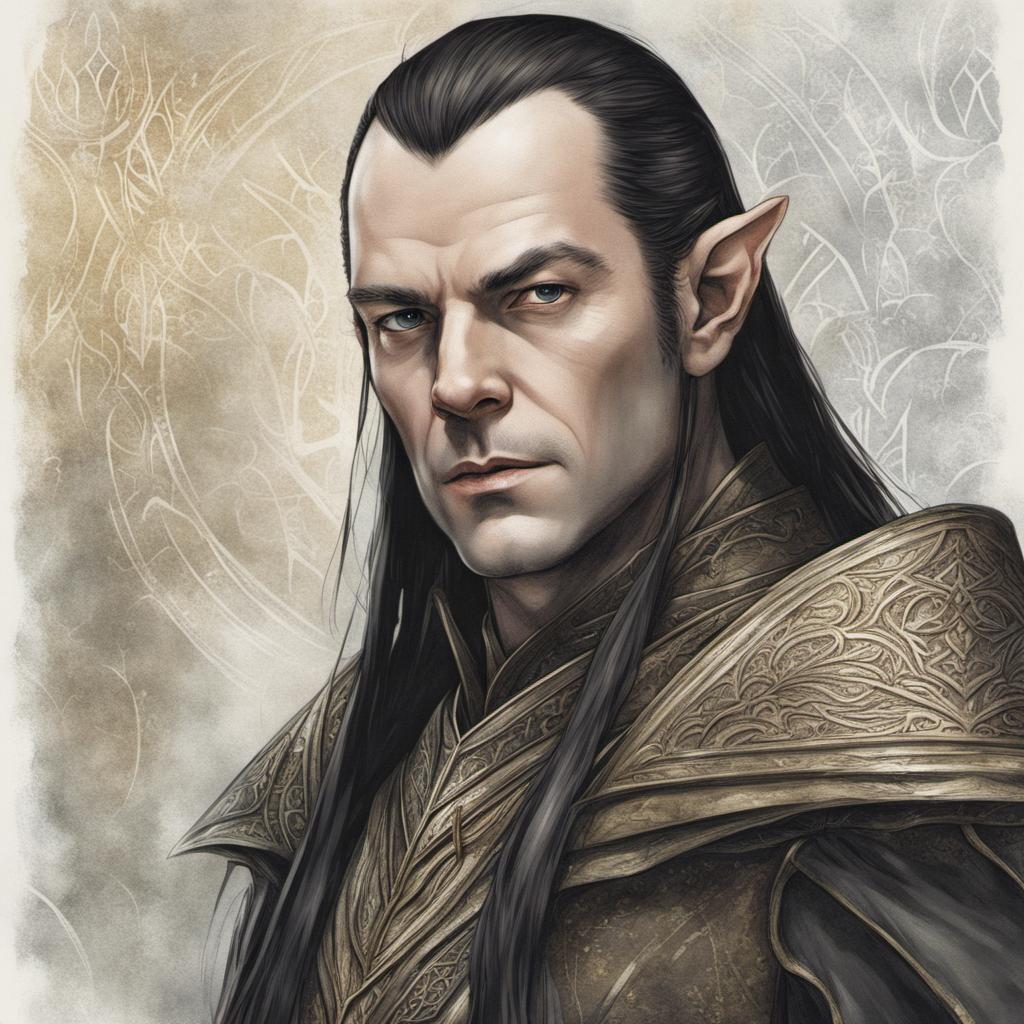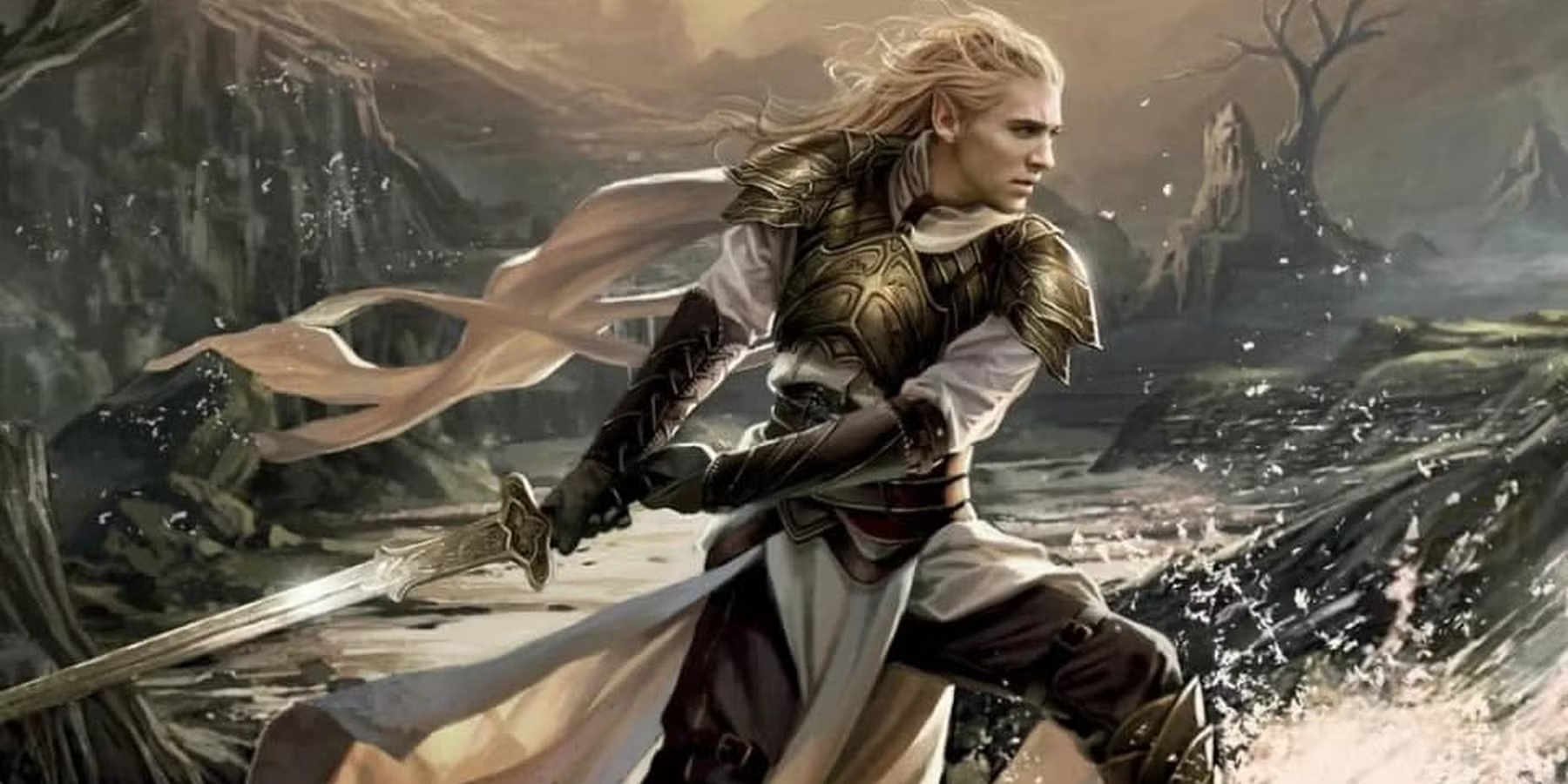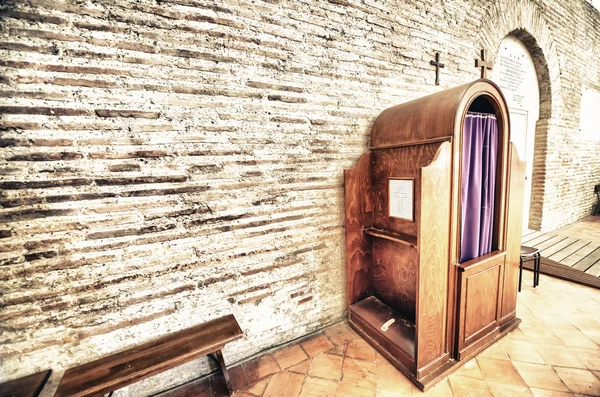Table of Contents
A Legacy of Two Worlds
Born in the First Age around the year 532, Elrond Half-elven entered the world at the Havens of Sirion in Beleriand—a refuge during one of Middle-earth’s most violent periods. His father, Eärendil the Mariner, and his mother, Elwing, were both of mixed Elven and Human descent. This rare dual lineage granted Elrond and his twin brother, Elros, a unique position in history as living bridges between two powerful races. Their ancestry traced back to the fabled union of Beren and Lúthien, whose love defied both fate and death, making the twins heirs to an extraordinary legacy shaped by courage, sacrifice, and divine intervention.
The world Elrond was born into was far from peaceful. At the time of his birth, the Elves were embroiled in devastating conflicts over the Silmarils—three radiant jewels crafted by Fëanor that inspired oaths, betrayals, and bloodshed. The Havens of Sirion, though intended as a sanctuary, stood on the front lines of these struggles, placing the young twins at the center of turmoil from the start. This chaotic backdrop imprinted itself deeply on Elrond, influencing his lifelong role as a unifier and peacemaker. His mixed blood and early exposure to the destructive consequences of ambition uniquely equipped him to navigate the complex politics of both Elves and Men.
A War for the Silmaril
In 538 of the First Age, the Havens of Sirion—once a sanctuary for Elves and Men—were devastated during the Third Kinslaying, a violent assault carried out by the sons of Fëanor. Their target was the Silmaril held by Elwing, a radiant jewel whose beauty and power had already sparked generations of bloodshed. The attackers showed little mercy, driven by an unbreakable oath sworn by their father. Amid this chaos, the young brothers Elros and Elrond were taken captive by Maedhros and Maglor. Rather than executing them, the two Elf-lords made an unusual choice: they raised the twins with unexpected gentleness and care despite their brutal legacy.
This experience would become a defining chapter in Elrond’s early life. Though born into a lineage of heroes, he was shaped equally by the harsh truths of betrayal and misplaced loyalty. Living under the care of Maglor—a tragic figure haunted by the weight of his father’s oath—he witnessed firsthand how noble intentions could be twisted by obligation. The emotional complexity of this fosterage helped form his nuanced perspective on justice, mercy, and identity. For Elrond, the Kinslaying was not just a story of loss but a harsh education in the shades of morality within his own kind, especially among the Elves.
The Burden of Blood and Choice
After Morgoth’s defeat in the War of Wrath, the Valar extended an extraordinary offer to the half-elven brothers Elros and Elrond: to choose which race they would belong to permanently. Their mixed heritage, a rarity in Arda, gave them a unique opportunity no other mortals or immortals had been granted. Elros chose the path of Men, embracing mortality and becoming the first King of Númenor. His decision shaped a powerful lineage of kings that would echo through ages. Meanwhile, his brother made a different choice—an equally weighty one—that would tie him to the fate of the Elves and the responsibilities that came with it.
Choosing immortality meant a life far removed from the cycles of birth and death known to Men. Elrond’s decision to be counted among the Elves reflected his deep connection to their culture, their language, and their long-term stewardship of Middle-earth. After his choice, he joined Gil-galad in Lindon, where he would serve under the last High King of the Noldor. This role was not ceremonial—he became a trusted counselor and administrator during a period of rebuilding and vigilance. Elrond’s acceptance of this path wasn’t simply personal; it was a declaration of duty to preserve the wisdom and stability of the Firstborn in an uncertain age.
A Hidden Valley Born from War
As Sauron’s armies swept across Middle-earth in the Second Age, few places remained untouched by his spreading shadow. One of the first to feel the blow was Eregion, a prosperous Elven realm famed for its craftsmanship and the forging of the Rings of Power. High King Gil-galad, aware of the looming danger, sent a military force under trusted command to support Eregion’s defense. But even with this aid, the city could not withstand the enemy’s might. When Eregion fell, the survivors needed leadership and direction. It was under these desperate conditions that Elrond guided the remnants north, seeking sanctuary far from the reach of Sauron’s influence.
In a remote and defensible valley tucked into the Misty Mountains, a new refuge was established: Imladris, or Rivendell. Shielded by towering cliffs and accessible only through narrow paths, it provided natural protection and isolation. Under Elrond’s guidance, the valley transformed into a haven where warriors could rest, healers could work, and loremasters could safeguard ancient wisdom. Rivendell was not merely a military retreat—it became a cultural stronghold, preserving Elven traditions and knowledge during a time when much of Middle-earth was in turmoil. Elrond’s founding of this refuge laid the foundation for a sanctuary that would endure for thousands of years.

The Power of the Ring of Air
Among the Three Rings of Power crafted by the Elves, Vilya—the Ring of Air—was held as the most potent. Crafted in secret and untouched by Sauron’s hand, it radiated purity and was associated with preservation, healing, and protection. Gil-galad, the High King of the Noldor, recognized its importance and chose a worthy bearer to wield it. When darkness grew and threats mounted, he entrusted the ring to a leader he trusted beyond all others. That bearer was Elrond, whose wisdom and unwavering sense of duty made him the ideal guardian of such a vital and powerful artifact during times of increasing peril.
With the power of Vilya, Rivendell became more than a hidden valley—it became a realm of peace and resilience. The ring enhanced Elrond’s natural abilities, allowing him to maintain Rivendell’s defenses against decay, despair, and evil influences. Its protective aura was subtle yet profound, creating an environment where culture, memory, and healing could endure. Ancient texts were preserved, songs were sung, and weary travelers found rest in a realm untouched by the advancing shadow. The tranquility of Rivendell was not the product of isolation alone, but of Vilya’s steady influence, wielded with purpose and care by its wise and enduring steward.
A Union of Great Houses and Enduring Love
The marriage between Celebrían and her husband represented a powerful alliance within the Elven world, joining the noble houses of Lothlórien and Rivendell. Celebrían, daughter of Celeborn and Galadriel, brought with her a lineage of wisdom and strength, while her union solidified bonds between two major Elven realms. Together, they had three children—twin sons Elladan and Elrohir, and a daughter, Arwen Undómiel—each carrying the legacy of both lineages. Their family embodied the unity of purpose among the Elves in a time of growing darkness. For Elrond, these familial connections reinforced the responsibilities he bore, both as a father and a guardian of his people’s future.
The happiness of their household was shattered in the year 2509 of the Third Age when Celebrían was ambushed by Orcs in the treacherous Redhorn Pass. Though rescued by her sons and physically healed through the efforts of Elrond, the emotional wounds inflicted by the ordeal were far more difficult to mend. Overcome by lingering fear and sorrow, Celebrían could no longer find peace in Middle-earth. She chose to sail to Valinor the following year, seeking healing beyond mortal shores. Her departure left a lasting void in the household, and Elrond’s grief deepened his resolve to protect others from such suffering.
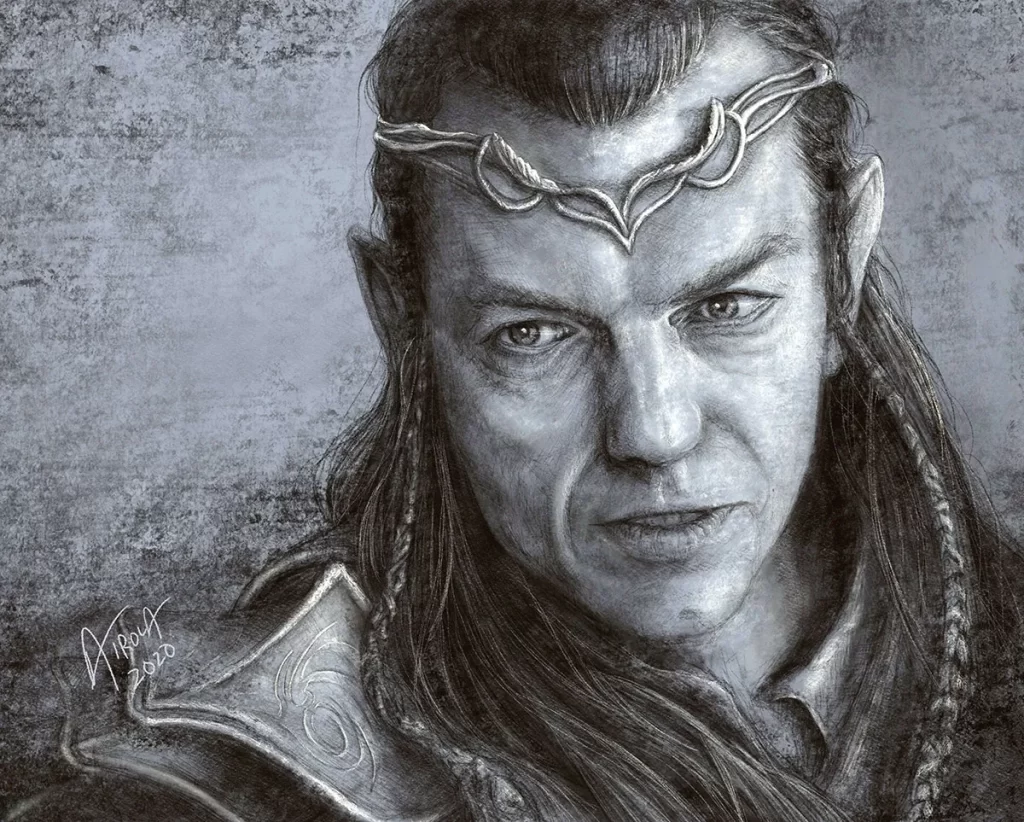
Guiding the Line of Kings
After the fall of Arnor, the northern kingdom founded by Isildur, its royal bloodline faced extinction. To safeguard this legacy, guardianship of the remaining heirs was entrusted to a trusted and enduring protector. The child born as Aragorn II, last of the line, was brought secretly to Rivendell and raised under the name Estel, meaning “hope.” Hidden from enemies and unaware of his lineage in early youth, he received a noble education in lore, combat, and leadership. Elrond recognized the importance of preserving Isildur’s line, not merely for tradition but because its future held the key to Middle-earth’s long-awaited healing.
Elrond raised Aragorn with care, offering him the same respect and attention he would show his own kin. As Aragorn matured and learned the truth of his heritage, he fell in love with Arwen, the daughter of his guardian. Their bond was strong, but not taken lightly. Knowing the weight of such a union, Elrond declared that Aragorn could only marry Arwen if he achieved something extraordinary—reuniting the kingdoms of Arnor and Gondor. This condition was not born of pride, but of foresight. By setting this challenge, Elrond ensured that Aragorn’s destiny would be earned, not inherited, and would truly reflect the strength of the line he represented.
A Meeting That Changed Middle-earth
In the year 3018 of the Third Age, Rivendell became the stage for one of the most consequential gatherings in the history of Middle-earth. Known as the Council of Elrond, it brought together key figures from across the Free Peoples—Elves like Legolas, Dwarves like Gimli, Men like Boromir, and Hobbits including Frodo and Sam. The purpose was urgent: to determine the fate of the One Ring, a source of immense power and danger. Elrond presided over the debate, drawing from centuries of knowledge and perspective. The council concluded that the Ring could not be hidden or used—it must be destroyed at its source: Mount Doom.
The outcome of this council was the formation of the Fellowship of the Ring, a group carefully selected to represent a unified front against Sauron. The Fellowship consisted of nine members, chosen not for their similarity but for their strengths and the symbolism of their alliance. Among them were Aragorn, Gandalf, and Legolas—leaders in their own right—yet bound together by purpose rather than rank. Elrond’s decision to trust diverse peoples to work together was bold and unprecedented. His single contribution was not only organizing the council but ensuring the Fellowship’s foundation rested on hope, balance, and shared responsibility against encroaching evil.
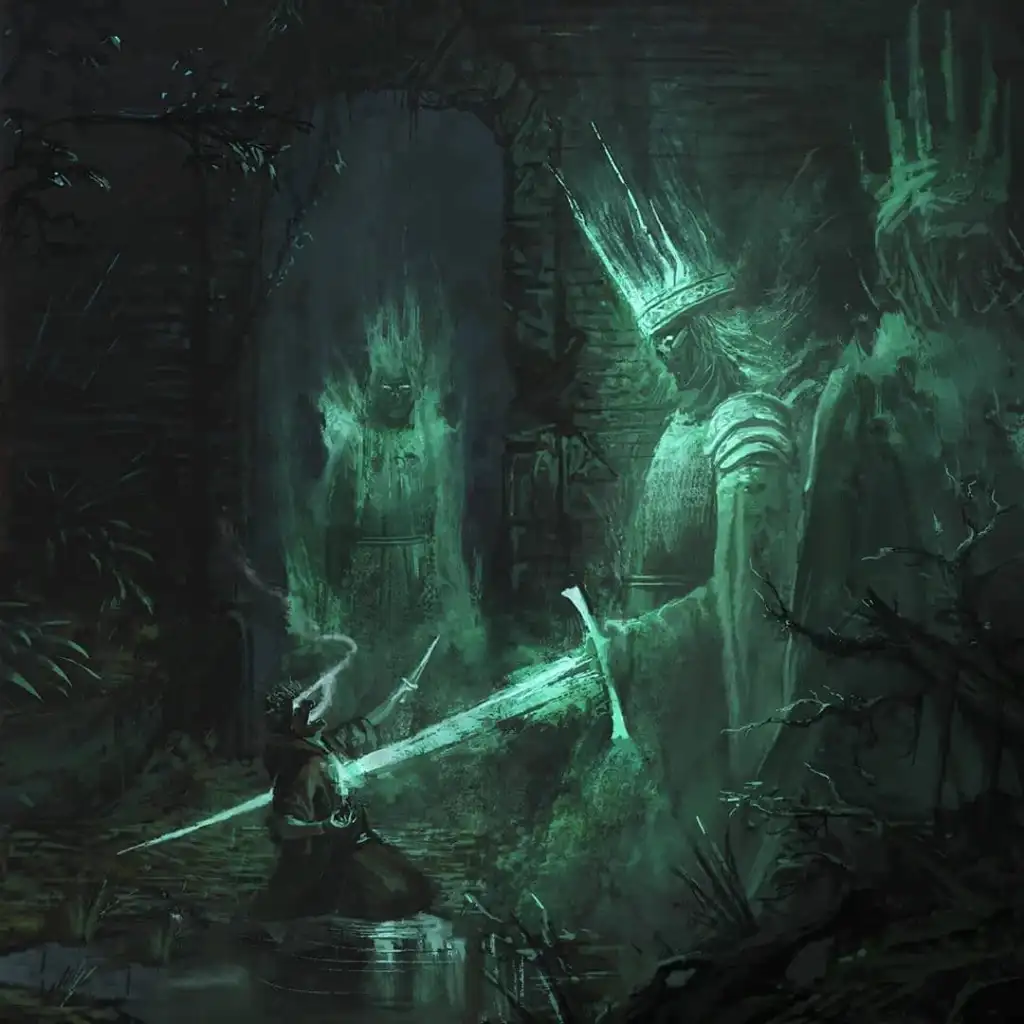
A Keeper of Wisdom and Wounds
While many saw Rivendell as a place of rest, it also stood as one of Middle-earth’s foremost centers for healing and scholarship. Its master was gifted not only in strategy and leadership but in medicine and lore. When Frodo Baggins was stabbed by a Morgul blade—an enchanted weapon that slowly turned its victims into wraiths—it was here that he was healed, a feat few could accomplish. The knowledge required went far beyond simple remedies; it demanded an understanding of dark sorcery and Elvish spiritual healing. Elrond applied ancient techniques that countered the Morgul influence, demonstrating his rare skill in treating wounds both of the body and the soul.
Elrond’s wisdom extended beyond healing to the safeguarding of Middle-earth’s historical and cultural memory. Rivendell housed countless scrolls, maps, and artifacts from earlier ages, maintained through meticulous care and oral tradition. When Thorin Oakenshield’s company passed through, it was in this haven that secrets of the Moon Runes on Thror’s Map were revealed, helping the dwarves unlock the path to Erebor. As a lore-master, Elrond ensured that knowledge lost in war or shadow could be rediscovered and passed on. His commitment to preserving truth and memory fortified the resistance against ignorance and tyranny, one word and remedy at a time.
The Last Sailing from the Grey Havens
In the year 3021 of the Third Age, one of the final ships departed from the Grey Havens, carrying the last of the great Elven figures to the Undying Lands. Among the passengers were the Ring-bearers—Gandalf, Galadriel, and the Hobbits Bilbo and Frodo Baggins—each granted passage for their roles in the War of the Ring. With them went one more: a leader who had shaped the fate of Middle-earth for thousands of years. Elrond’s departure was not only a farewell but a signal that the time of the Elves was ending. The Age of Men had begun, and a long chapter in history quietly closed.
Although his ship vanished over the horizon, the influence of Elrond continued to ripple through Middle-earth. His daughter Arwen, once immortal, chose a mortal life to marry Aragorn, forging a union that healed ancient divisions between Elves and Men. This alliance bore deep symbolic weight, fulfilling hopes kindled generations earlier. Elrond’s legacy lived not only in bloodlines but in values—wisdom, resilience, and compassion. Through those he guided, healed, and counseled, his presence remained embedded in the world he left behind. In every peaceful sunrise over Gondor, one could trace the silent echoes of his long, enduring guardianship.
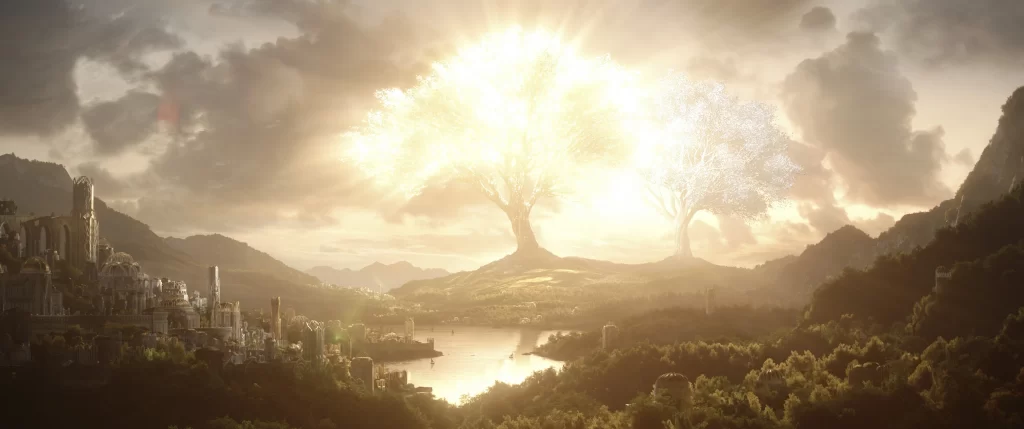
A Legacy Carried Through Performance
Elrond’s presence has extended far beyond the pages of Tolkien’s legendarium, reaching millions through powerful film and television portrayals. In Peter Jackson’s acclaimed film trilogies, Hugo Weaving brought Elrond to life with solemn authority and layered restraint, portraying a leader burdened by history yet driven by duty. Weaving’s performance highlighted the weight of immortality and the emotional cost of leadership. In a different era, Amazon’s The Rings of Power introduced viewers to a younger version of the character, played by Robert Aramayo. This interpretation explored Elrond’s formative years, giving new depth to his ambitions, doubts, and the political tensions of the Second Age that shaped his path.
Despite differences in medium and tone, each portrayal honors the heart of Elrond’s character: a bridge between worlds, a steward of knowledge, and a protector of Middle-earth’s future. His narrative resonates because it is steeped in universal themes—grief, sacrifice, and unwavering purpose. Whether counseling a Hobbit or standing against evil, Elrond’s influence is central to the emotional and moral architecture of Tolkien’s world. Through cinema, television, and continued literary exploration, Elrond’s journey continues to engage new generations, securing his place not just as a lore figure but as a lasting cultural icon in fantasy storytelling.
How useful was this post?
Click on a star to rate it!
Average rating / 5. Vote count:
No votes so far! Be the first to rate this post.
Author
-
Meet Dr. Kendall Gregory, a highly accomplished professional with a remarkable academic background and a deep passion for empowering individuals through knowledge. Dr. Gregory’s educational journey began with a Bachelor of Science degree, followed by a Doctor of Chiropractic Medicine, focusing on diagnosing and treating musculoskeletal conditions. He further expanded his expertise with a Master's degree in Oriental Medicine, specializing in acupuncture and Chinese herbology, and a Master's degree in Health Care Administration, emphasizing his dedication to improving healthcare systems. Dr. Gregory combines his extensive knowledge and practical experience to provide comprehensive and integrative healthcare solutions. Through his writings, he aims to inspire individuals to take charge of their health and make informed decisions.
View all posts

